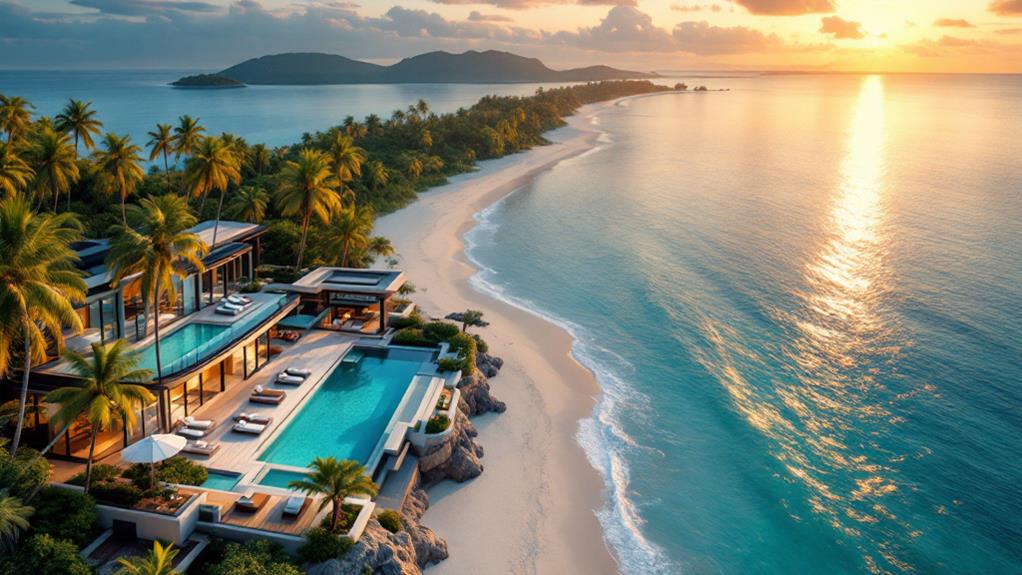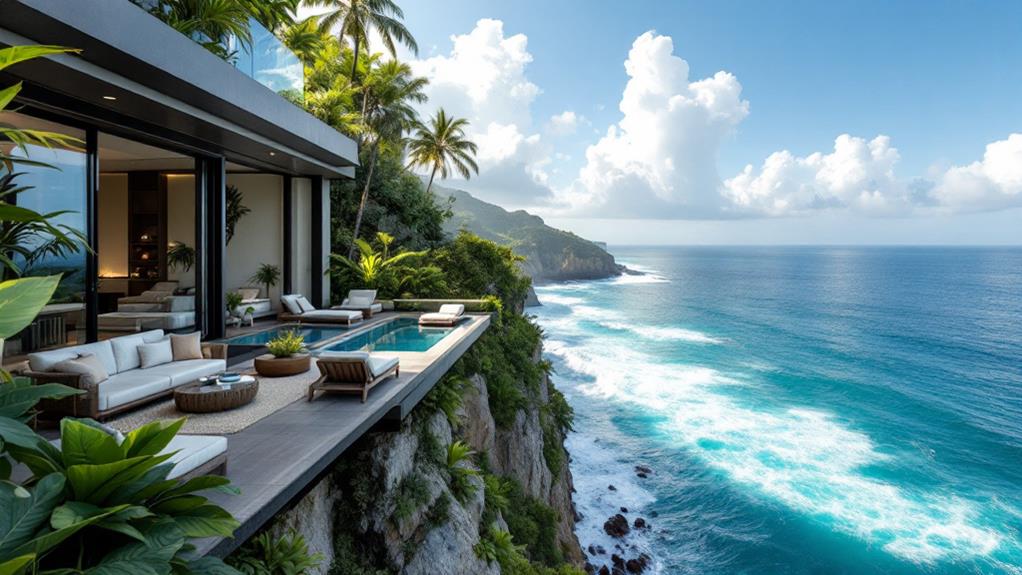The Most Beautiful Palaces in the World You Can Visit
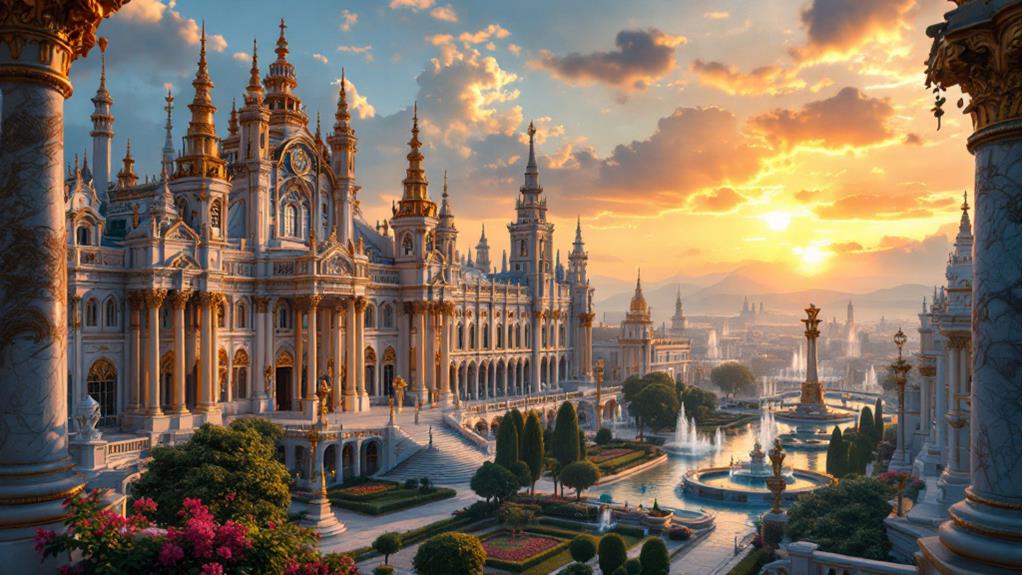
You'll find some of the world's most stunning palaces that are open for visitors. Start with the iconic Hawa Mahal in Jaipur, a majestic tower of pink sandstone. Investigate the Château de Chambord in France, famous for its French Renaissance style and Leonardo da Vinci's influence. Schönbrunn Palace in Vienna and the ornate Palace of Versailles in France are both UNESCO sites with expansive gardens. Don't miss Spain's Alhambra for its Islamic architecture or Germany's fairy-tale Neuschwanstein Castle. Each palace offers a unique glimpse into history, and diving deeper will reveal more about these architectural marvels.
Hawa Mahal, Jaipur
Often considered an architectural marvel, Hawa Mahal in Jaipur invites you to investigate its fascinating history and design. Built in 1799 by Maharaja Sawai Pratap Singh, this iconic structure, also known as the Palace of Winds, was crafted for royal ladies to discreetly observe street festivals through its 953 latticed windows. These windows not only maintain privacy but also allow cool breezes to flow through, providing natural ventilation to keep the palace's interior comfortable.
Constructed from pink sandstone, Hawa Mahal stands as a stunning example of Rajput architecture. Its intricate honeycomb latticework and decorative motifs showcase the artistry and attention to detail characteristic of this style. The palace's orientation on an east-west axis enhances natural cooling and sunlight exposure, a demonstration of the ingenious design strategies employed at the time.
Hawa Mahal is part of the larger City Palace complex in Jaipur, solidifying its historical significance and making it a must-see tourist attraction. As you delve into its stunning design and learn about its purpose for the royal ladies, you'll gain a deeper appreciation for this architectural gem and its place in history.
Château De Chambord
After exploring the intricate beauty of Hawa Mahal, your expedition to the world's stunning palaces continues with the awe-inspiring Château de Chambord in France's Loire Valley. This magnificent palace began its construction in 1519 under King François I, embodying the grandeur and elegance of French Renaissance architecture. With 440 rooms and 365 fireplaces, Château de Chambord stands as a demonstration of the opulence of a bygone period.
The château's iconic roof, adorned with an intricate array of turrets and chimneys, showcases architectural brilliance that is instantly recognizable. It's believed that Leonardo da Vinci influenced the design, infusing it with artistic and cultural depth. As you wander through its vast halls, you'll feel the blend of history and creativity that defines this majestic structure.
Surrounding the château, the formal gardens, beautifully restored in 2017, improve its historical beauty, offering picturesque landscapes that captivate visitors. These gardens provide a serene setting to appreciate the grandeur of Chambord, making your visit an unforgettable experience. In the Loire Valley, the Château de Chambord remains a symbol of historical splendor and architectural innovation.
Schönbrunn Palace, Vienna
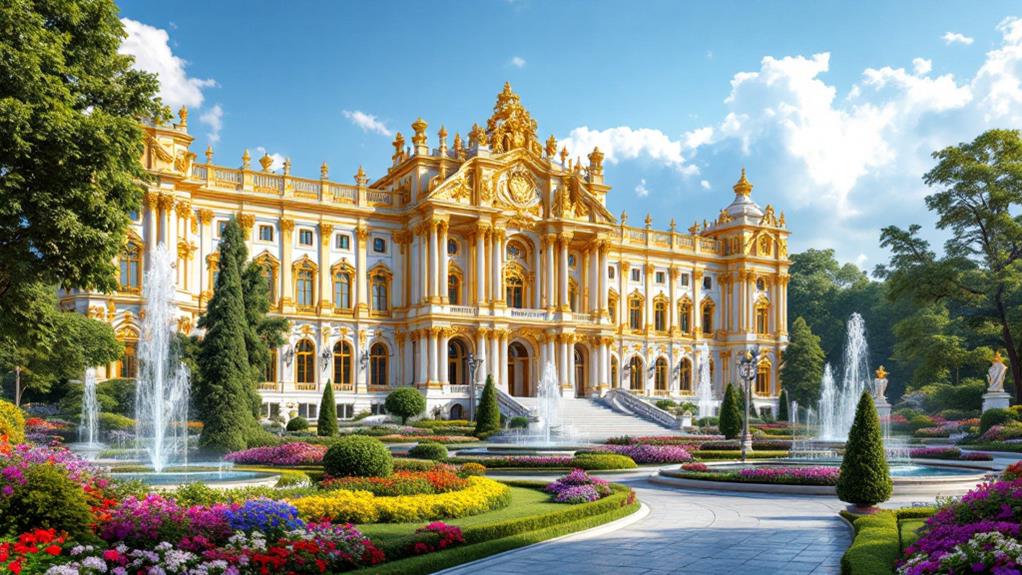
A trip to the glorious Schönbrunn Palace in Vienna offers a glimpse into the grandeur of the Habsburg monarchy. Commissioned in 1693 by Emperor Leopold I, this stunning Baroque style palace later became a favored summer residence for Empress Maria Theresa in the 18th century. As you navigate, you'll be captivated by its opulent interiors. With 1,441 rooms, only 40 are open for public tours, each showcasing lavish decorations and intricate designs reflective of its historical significance.
The palace is surrounded by vast gardens, designed by Jean Trehet, a student of the famed André Le Nôtre. These gardens boast beautifully arranged flowerbeds, serene fountains, and a botanical garden that invites peaceful discovery. Don't miss the Tiergarten Schönbrunn, the world's oldest zoo founded in 1752, which remains one of Vienna's top attractions.
In 1996, Schönbrunn Palace was rightfully designated a UNESCO World Heritage site, recognized for its architectural beauty and rich history. Regardless of whether you're marveling at its Baroque charm or strolling through the lush gardens, Schönbrunn Palace offers an unforgettable expedition into Austria's royal past.
Palace of Versailles
Step into the grandeur of the Palace of Versailles, a magnificent symbol of absolute monarchy in France. Originally a humble hunting lodge for Louis XIII in 1623, it was transformed into a grand royal residence by his son, Louis XIV, in 1682. This stunning palace epitomizes French opulence and showcases the architectural grandeur of the period. As you investigate, you'll be captivated by the iconic Hall of Mirrors, which boasts 357 mirrors reflecting the brilliance of its crystal chandeliers and gilded decor.
The Hall of Mirrors is just one of the many gems that await you at Versailles. Outside, you'll find the breathtaking gardens designed by André Le Nôtre. Spanning approximately 800 hectares, these gardens are a masterpiece of landscape design, filled with intricate fountains, sculptures, and meandering pathways that invite you to wander and marvel.
Recognized as a UNESCO World Heritage Site in 1979, the Palace of Versailles continues to draw millions of visitors each year. Inside, it houses a vast collection of art and historical artifacts, including paintings by renowned artists like Antoine Watteau and François Boucher. Each piece adds to the palace's historical significance and rich cultural tapestry.
Alhambra, Granada
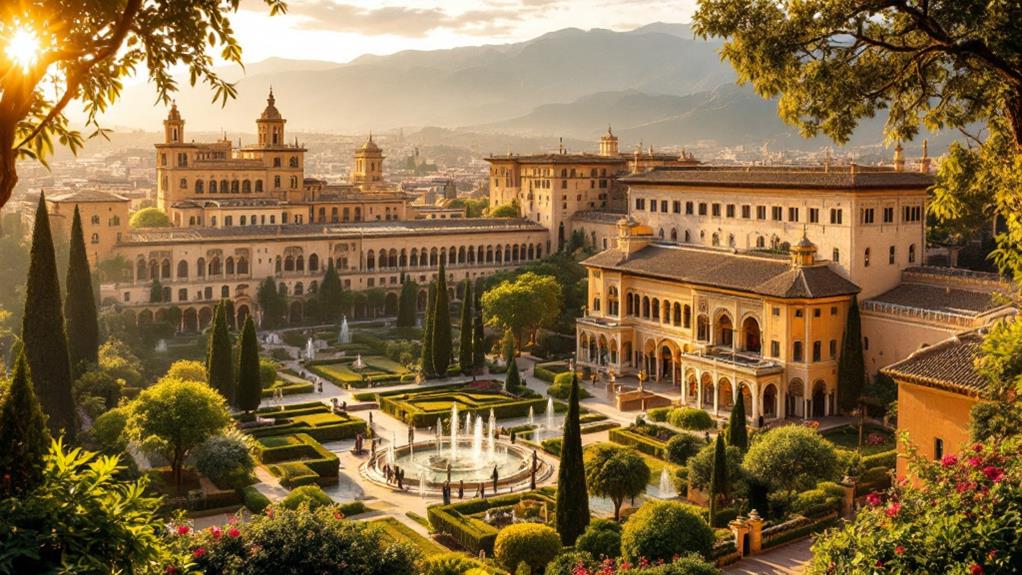
Prepare to be enchanted by the Alhambra in Granada, Spain, a stunning 13th-century palace and fortress complex that showcases the pinnacle of Islamic architectural brilliance. As you traverse this UNESCO World Heritage site, you'll be captivated by its intricate designs and the masterful Moorish craftsmanship visible in every detail. The Alhambra's cultural significance is profound, drawing millions of visitors every year to witness its splendor.
Imagine walking through:
- The Court of the Lions: Marvel at the graceful fountain surrounded by elegant arches and columns.
- Nasrid Palaces: Admire the dazzling mosaic tiles and arabesque motifs that adorn the walls.
- Beautiful gardens: Stroll through the lush Generalife, the sultans' summer retreat, filled with fragrant flowers and serene water features.
The Alhambra isn't just a feast for the eyes; it's a voyage back in time, offering a glimpse into the opulent lives of the Nasrid rulers who once called this place home. Its historical and cultural importance makes it a must-visit destination. Regardless of whether you're captivated by the ornate architecture or the tranquil gardens, the Alhambra promises an unforgettable experience in the heart of Granada.
Neuschwanstein Castle
While the Alhambra enchants with its Moorish elegance, Neuschwanstein Castle transports you to a domain of fairy tales in Bavaria, Germany. King Ludwig II commissioned this iconic masterpiece in 1869, and its fairy-tale appearance has captivated imaginations ever since. Situated in a picturesque setting, the castle stands as a reflection of Ludwig's love for Wagnerian operas and medieval aesthetics.
Neuschwanstein Castle showcases a magnificent blend of architectural styles, including Romanesque, Gothic, and Byzantine influences. These styles come together to create intricate interiors, with the majestic Singers Hall as a particular highlight. Designed by architect Eduard Riedel, the castle embodies the romantic vision of a medieval knight's castle, making it one of the most popular tourist attractions in Germany. Each year, over 1.3 million visitors flock to this enchanting site.
Restoration efforts are underway, expected to be completed by spring 2024, ensuring the preservation of its historical significance and beauty for future generations. As you wander through its halls, you can't help but feel the magic and wonder that King Ludwig II sought to capture—a true fairy tale brought to life.
Grand Palace, Bangkok
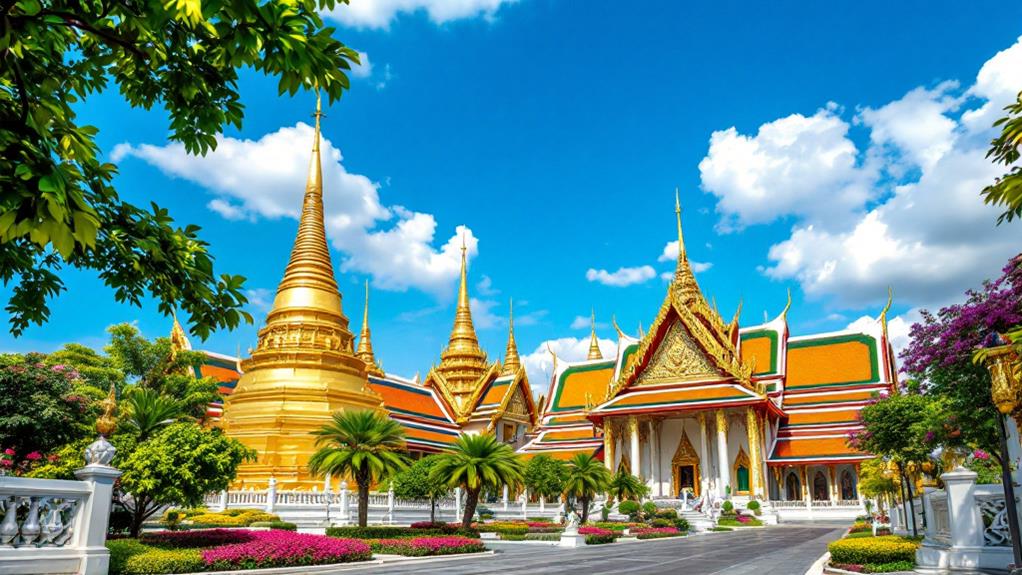
The Grand Palace in Bangkok, established in 1782, stands as a symbol of Thailand's rich cultural heritage and royal history. This magnificent site, once the official residence of the Kings of Siam, covers over 2.3 million square feet. As you wander through this sprawling complex, you'll be captivated by its more than 100 buildings, each showcasing traditional Thai architectural styles and intricate designs.
Within the palace grounds, you'll uncover:
- The stunning Temple of the Emerald Buddha, housing a revered statue carved from a single jade block.
- Beautiful gardens that offer a serene escape and a glimpse into the palace's lush landscape.
- Majestic ceremonial halls where numerous royal ceremonies have unfolded over the years.
The Grand Palace remains a significant cultural and historical site in Thailand, drawing millions of visitors annually. It's a place where you can engage yourself in the grandeur of Thai royalty and investigate the fascinating history that envelops the palace walls. Regardless of if you're marveling at the intricate designs or strolling through its beautiful gardens, the Grand Palace in Bangkok offers an unforgettable experience that connects you with Thailand's royal past.
Forbidden City, Beijing
As you leave the opulence of Bangkok's Grand Palace, your expedition to investigate regal history continues in Beijing at the awe-inspiring Forbidden City. Constructed from 1406 to 1420, this monumental site served as the imperial palace for the Ming and Qing dynasties, symbolizing China's imperial authority. Spanning approximately 180 acres, the Forbidden City claims the title of the largest palace complex in the world, with nearly 1,000 buildings and around 10,000 rooms.
The architecture, aligned along a north-south axis, showcases traditional Chinese design, with major structures facing south to capture ideal sunlight. A 10-meter high wall and a surrounding moat form a protective barrier, both defending the complex and representing its symbolic power. As a UNESCO World Heritage Site, the Forbidden City invites you to investigate its rich history and cultural significance.
Within its walls lies the Palace Museum, home to an extensive collection of Chinese art and historical artifacts. As you wander through the expansive courtyards and intricately designed halls, you'll be transported back in time, experiencing the grandeur and majesty that once defined China's imperial age. The Forbidden City is a must-see for any history enthusiast.
Pena Palace, Portugal
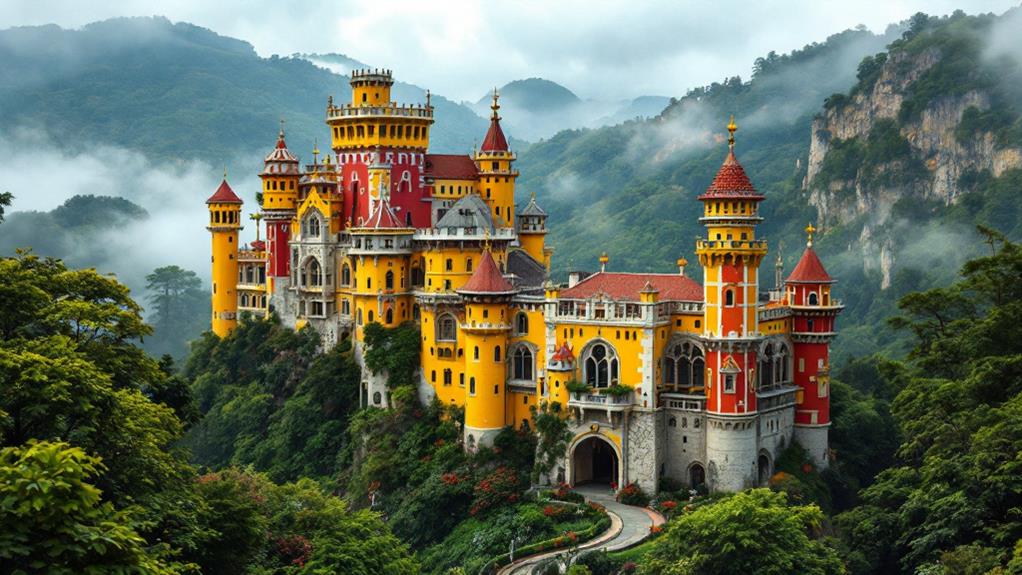
Situated in the Sintra Hills of Portugal, Pena Palace captivates with its lively colors and eclectic architectural styles. Built in the mid-19th century by King Ferdinand II, this palace is a delightful blend of Neo-Gothic and Manueline influences. Perched atop a hill at about 500 meters above sea level, it offers you breathtaking panoramic views of both the surrounding landscape and the picturesque town of Sintra. As you wander through this UNESCO World Heritage site, you'll be enchanted by its fairy-tale appearance.
- Vibrant colors: The palace's vivid hues of red and yellow create a striking contrast against the lush greenery of the Sintra Hills.
- Eclectic architectural styles: With fanciful turrets and ornate balconies, the palace embodies the Romanticist ideals of the period.
- Richly decorated rooms: Inside, you'll find lavish interiors adorned with historical artifacts that transport you back in time.
Don't miss exploring the beautifully landscaped gardens that improve your experience of this architectural marvel. Originally a medieval chapel dedicated to Our Lady of Pena, the current structure was completed in 1854, fully embracing Romanticist ideals. It's a must-see destination that promises an unforgettable expedition into the past.

